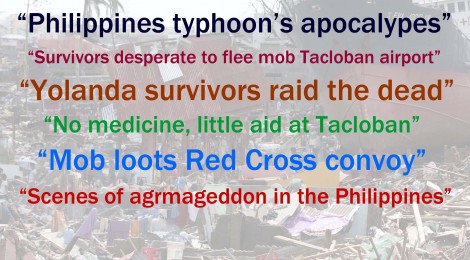
Typhoon in the Philippines: reading between the lines of sensationalist journalism
For those who followed the news of the Philippines in the aftermath of typhoon Haiyan / Yolanda, the picture was one of a flailing government with no response capacity and even worse disaster preparedness. Throw in some looters and US military helicopters and you now have the typical image that everyone expects from a disaster in a developing country. Based on past experiences, I’m pretty sure this image is bullshit.
Let me preface my message by saying that I am deeply concerned with the impact that this disaster has had (and will continue to have) on the lives of the millions affected by the typhoon. I will also say that I am not currently in the Philippines, and so my comments are based on past experiences in disasters in which the same post-disaster myths were promulgated.
On looting:
Some refreshing pieces have been written about the “post-disaster looting myth” (from the Guardian, Rebecca Solnit, Prof. John Twigg, and others). It is the same in every disaster. The media finds isolated instances of “looting” and amplifies it to a generalized everyone-for-himself panic. It was the same following the 2010 Haiti earthquake, and Katrina (and again) before that.
On scaremongering:
This article by Time entitled “Stop Catastrophizing Relief Efforts in the Philippines” sheds some light on the inflated security threats and “slow relief” parroted by the media and its negative effects on the response process. In short, the helicopters of the news crews will always arrive before the large relief supply trucks/planes/ships. So asking “why is relief not there?” is missing the point. Furthermore, the security-related scaremongering hinder aid agencies from full deployment until security support is ensured, even if it’s often not needed.
On the Philippines is not Japan:
I am particularly frustrated with the many comparisons between the Philippines and Japan. Clearly, the Philippines is not Japan (thanks for clarifying that for us Washington Post). But comparing typhoon Yolanda in the Philippines to the Tohoku earthquake in Japan is completely nonsensical. These are completely different countries, contexts and hazards! These reports also fail to mention that the 2011 Tohoku earthquake in Japan in fact killed 16,000 people and caused the largest nuclear accident since Chernobyl. If the comparison has any relevance, it’s that BOTH cases show that we need to prepare not only for our routine disasters, but also for very unlikely, extremely large events.
On the disaster response:
It is typical in the direct aftermath of a disaster event for people to point fingers, (usually at Government). People want to understand why a natural hazard escalated to a human disaster. We need to be cautious about gathering the proper lessons from this event. The Philippines has a long history of typhoons. In comparison to nations with “similar” development conditions (i.e. not Japan), the Philippines has engaged quite forcefully in a disaster risk reduction agenda in the past decade. It is no surprise that the most powerful typhoon to ever make landfall completely overwhelmed the Philippine government response capacity, as it would have practically any country. In the coming month however, it will be important to study what actually happened and what can be learned from it. What parts of the preparedness and disaster management program worked? Which parts failed and why? This is how progress is made.
Please also see these “Four Questions About This Super Storm and Major Humanitarian Disaster” by Elizabeth Ferris of the Brookings Institution.








